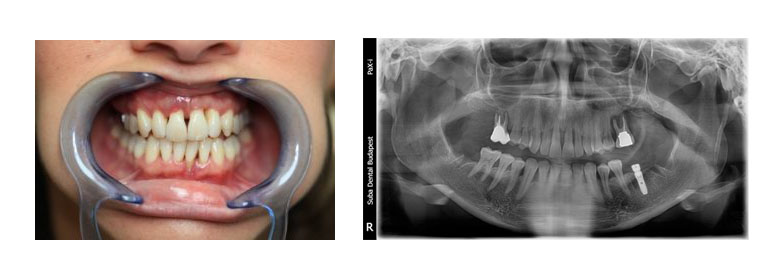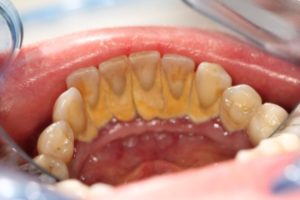PERIODONTOLOGY AND PERIODONTAL DISEASES
Periodontal diseases fall into two big categories: inflammation of the gum (gingivitis), which is restricted to the gum, and periodontitis, which also affects the periodontium (the tissue and bone supporting the tooth).
PERIODONTOLOGY AND PERIODONTAL DISEASES
Gingivitis is associated with red, swollen gums susceptible to bleeding when touched. If the patient does not report for dental scaling and neglects oral hygiene, the process may propagate to the supporting tissues of the tooth causing so-called periodontal pockets to form, which excrete blood and pus indicating inflammation.
Proportionately with the extent of bone decay, the teeth gradually become loose which leads to their eventual loss. Periodontal diseases usually develop insidiously, causing no pain and with complaints arising only in an advanced phase.
- bleeding gums
- bad breath (halitosis)
- swelling of the gum
- loosened teeth
- tooth migration, gap formation between the teeth
- tooth loss
Due to its slow progression, the most common form of the disease known as chronic periodontitis is mostly discovered in middle-aged patients.
The other form of the disease known as aggressive periodontitis appears at an early age with bone decay developing earlier and brings about more severe tissue loss and bone resorption.
Figure: clinical and radiological image of aggressive periodontitis (with a great extent of bone resorption visible around the upper molars)
The main reason underlying periodontal disease is plaque deposits on the tooth consisting of bacteria that subsequently develop into tartar bringing on the inflammation, and over time, the decay of the periodontium. Certain forms of the periodontal disease are hereditary, and due to the genetic nature of the disease, treatment may sometimes be less efficient. Certain behavioural factors such as smoking may aggravate periodontitis and compromise the results of the treatment. Patients suffering from periodontitis are particularly advised to quit smoking as well as to undergo check-ups and thorough dental scaling on a more frequent basis. Some systemic diseases, certain medications, pregnancy and immunological diseases may also contribute to the formation, or aggravation of periodontal disease. In many patients causal and aggravating factors frequently co-occur.
Periodontal disease is associated with irreversible tissue loss, which makes prevention all-important. To this end, an appropriate coordination of home oral hygiene, regular dental check-ups and professional oral hygiene treatments are required. The full team of our clinic including the dental hygienist, periodontist and the dentist are available to give instruction on appropriate tooth brushing techniques and the selection of oral hygiene devices.
Once the periodontal disease has already developed, a periodontal treatment approved by a periodontist is required.
The most frequently performed periodontal treatments:
Supra – and subgingival scaling (calculus removal), tooth scaling and root planning
Professional supra- and subgingival scalingessentially consists in the elimination of the inflammation, avoiding the progression of tissue decay and the prevention of the recurrence of periodontal disease. Causal periodontal treatment primarily consists in the removal of plaque and tartar (calculus) causing the disease as well being able to maintain proper home oral hygiene.
Closed curettage
Closed curettage (periodontal intervention) is the removal of plaque and calculus performed on locations inaccessible to the patient such as under the gum and on the surface of the root. Mechanical cleaning such as ultrasonic scaling and curettage is often complemented with chemical antiseptics, which means a chlorhexidine rinse following curettage and using a chlorhexidine mouthwash at home. Following the intervention, the gum “sucks” back onto the cleaned root eliminating the pockets the patient was incapable of cleaning.
Open Curettage
In case of a more advanced from of periodontitis, that is, with deep periodontal pockets and bone resorption, a closed curettage will not suffice. In such instances, an open curettage (surgical periodontal intervention) is advised. In the course of periodontal pocket surgery, the root surfaces are exposed to afford the periodontist better accessibility and visibility for cleaning. In severe cases the periodontal disease may be so advanced that, multiple tooth extraction may also be indicated in order to prevent the propagation of the disease.
All-round periodontal treatment may sometimes require more than a closed curettage or periodontal pocket surgery. In some instances correctional surgery and conventional or implant tooth replacements may also be required.
With patients, suffering from periodontal disease it is particularly important that the preserved teeth are periodontally cleaned and treated prior to implantation. Long-term success lies in implantation carried out in an inflammation-free area and good oral hygiene.
Periodontal disease requires lifelong attention with regular check-ups or periodontal care. For efficient treatment and maintaining good results, the patient’s cooperation is indispensable, as is compliance with the periodontist’s advice as regards changes in lifestyle.








